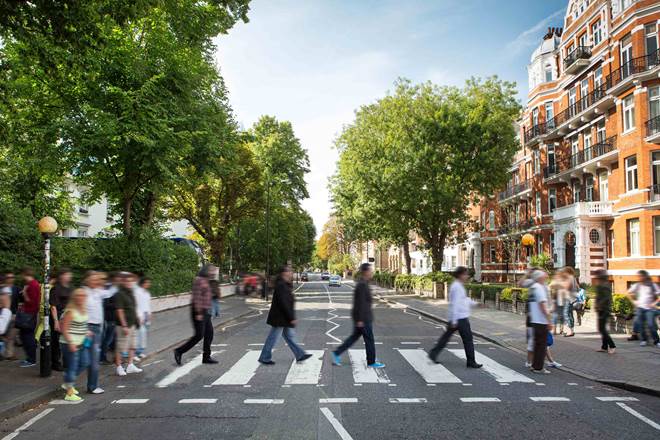To the untrained eye, the Abbey Road crossing is a completely ordinary crosswalk—or, as the British call it, a “zebra crossing”—just north of central London.
To music fans, it’s a source of inspiration—a way to connect with one of the greatest musical acts in history by literally walking in their footsteps.
The Beatles put this humble corner of London on the map via their eleventh (and penultimate) album, Abbey Road. The album includes some of the band’s biggest and most ambitious songs ever, including “Come Together", and the album cover—featuring the Fab Four crossing the aforementioned road—is one of the most iconic pieces of cover art in music history.
It’s no wonder that this street and Abbey Road Studios have become a go-to destination for tourists visiting London, but what’s the history of Abbey Road? And how can you plan a day around this destination? First of all…
Image credit: Getty Images, Colors Hunter
Is Abbey Road a road, a crossing, or a studio?
All of the above!
Abbey Road is quite literally a road running roughly north-south in the London neighborhood of St John’s Wood. Abbey Road crossing is also simply a road crossing. And Abbey Road Studios is a famous recording studio on Abbey Road, right by the crossing.
A converted Georgian townhouse, Abbey Road Studios has been a recording studio since 1929. Initially called EMI Recording Studios, it was a popular spot for musicians of various genres and was the primary recording home for The Beatles in the 1960s. Later, as an homage to The Beatles, the studio rebranded to Abbey Road Studios and it remains an active and renowned recording studio to this day.
What is the nearest tube station to Abbey Road?
Abbey Road is a roughly five-minute walk from St. John’s Wood Underground Station on the Jubilee line. Fairly central, you can expect a roughly 20-minute commute from King’s Cross, or a 30-minute commute from Victoria station.
Image Credit: Getty Images, Matt Carr
What to do at Abbey Road?
The obvious answer is cross the street. Do it by yourself or with a group of friends. Do it for yourself or for an Instagram story. Whichever way you do it, it’s a fun way to connect with an iconic slice of British culture.
As for Abbey Road Studios, there’s plenty on offer, including full-on guided tours. Just remember that it’s an active recording studio, so you can’t just waltz in without booking in advance. Tickets and available times are listed on the website. Beyond that, the studio has a public graffiti wall—a perfect way to leave your mark on this iconic landmark. And, of course, the requisite gift shop.
Image Credit: Getty Images, Alex Robinson Photography. Image Location: Primrose Hill
Is Abbey Road worth a visit?
You’ve completed your trip to Abbey Road… now what? Depending on whether you book a studio tour, visitors can expect to spend 30 minutes to a few hours in Abbey Road Studios. A fun trip, sure, but not exactly a full day.
Thankfully, once you’re done at Abbey Road, you’re basically still in central London, with loads of other walkable options to head to. Here are four nearby places to check out:
- St John’s Wood High Street. Pubs, restaurants, and cafes dot this middle-to-upper-class corner of London, located right by the Underground station you likely took to get to Abbey Road. Perfect for a coffee, a pint, a snack, or a meal.
- Regent’s Park. One of London’s best parks is a short 15-minute walk from Abbey Road. Regent’s Park is home of the London Zoo, and Queen Mary's Rose Gardens.
- Primrose Hill. Just on the northern edge of Regent’s Park, Primrose Hill has one of the best views of London.
- Lord’s Cricket Ground. One of several iconic cricket grounds in London, this storied venue is a perfect spot for the sporty tourist. Even if there isn’t a match on, the stadium is worth a look, with tours being held on regular intervals.
And the best way to get from Heathrow to Central London...
Download the Trainline App today to book your tickets from Heathrow to London. Plus, check out our other articles on what to do in London's West End and the best street-food markets.
Header Image Credit: Getty Images, Richard Boll
